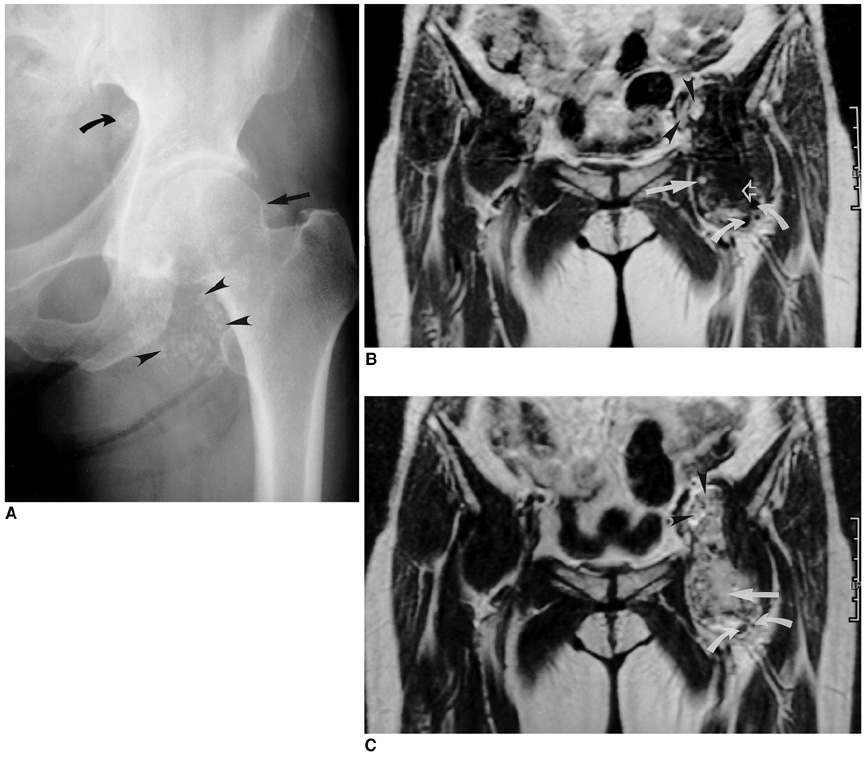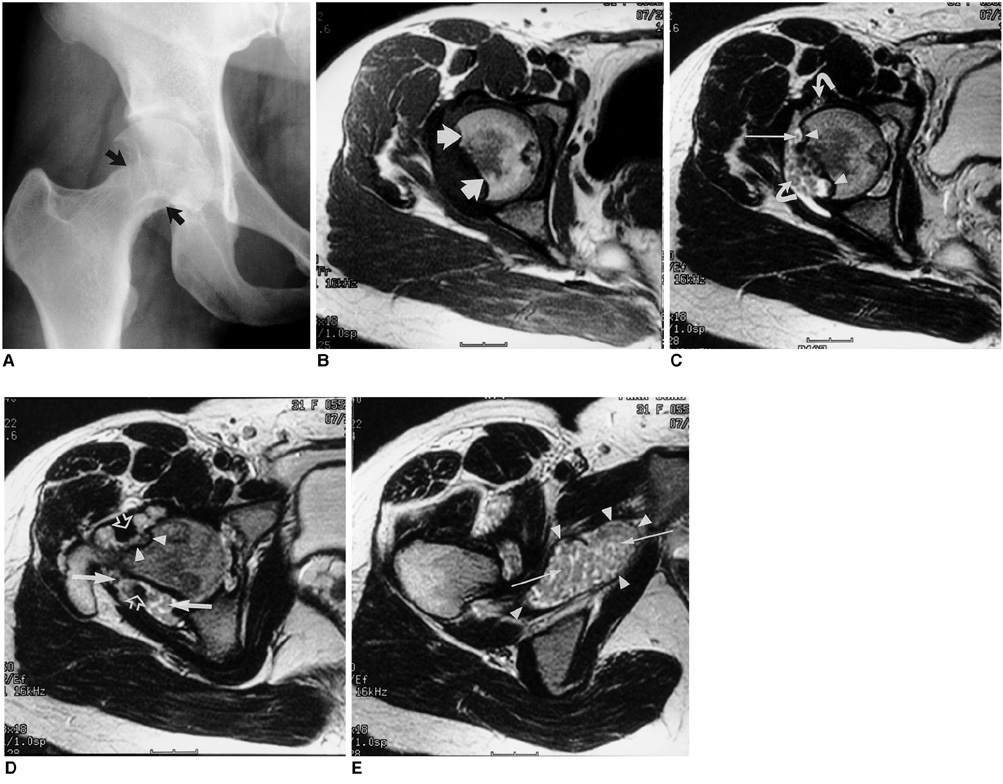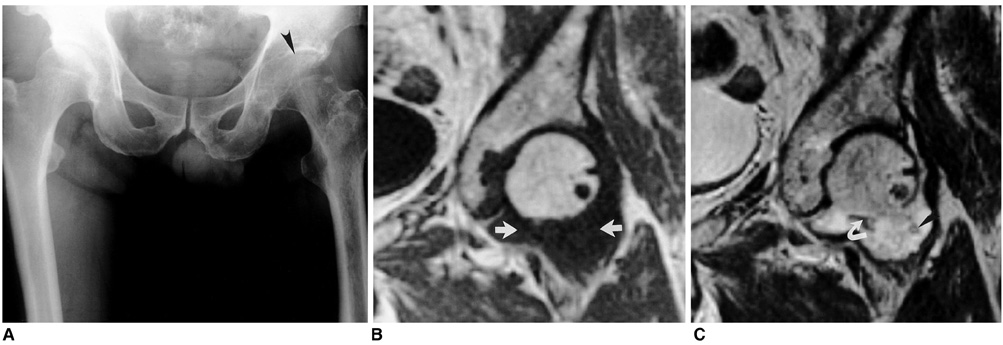Korean J Radiol.
2002 Dec;3(4):254-259. 10.3348/kjr.2002.3.4.254.
Idiopathic Synovial Osteochondromatosis of the Hip: Radiographic and MR Appearances in 15 Patients
- Affiliations
-
- 1Department of Radiology, Samsung Medical Center, Sungkyunkwan University School of Medicine, Korea. yspark@smc.samsung.co.kr
- 2Department of Orthopedic Surgery, Samsung Medical Center, Sungkyunkwan University School of Medicine, Korea.
- KMID: 1118793
- DOI: http://doi.org/10.3348/kjr.2002.3.4.254
Abstract
OBJECTIVE
To evaluate the radiographic and MR appearance of idiopathic synovial osteochondromatosis of the hip. MATERIALS AND METHODS: Radiographs and MR images of 15 patients with idiopathic synovial osteochondromatosis of the hip were assessed. The former were analysed in terms of the presence of 1) juxta-articular calcified and/ or ossified bodies, 2) osteophytes, 3) bone erosion, 4) juxta-articular osteopenia, and 5) joint space narrowing, while for the latter, analysis focused on 1) the configuration of intra-articular bodies, 2) bone erosion, 3) synovial thickening, 4) conglomeration of intra-articular bodies, and 5) extra-articular extension. RESULTS: At hip radiography, juxta-articular calcified and/ or ossified bodies were seen in 12 of the 15 patients (80%), bone erosion in eight (53%), osteophytes in seven (47%), juxta-articular osteopenia in five (33%) and joint space narrowing in five (33%). In eight patients (53%), MR imaging depicted intra-articular bodies of focal low signal intensity at all pulse sequences, and areas of isointensity at T1WI and hyperintensity at T2WI. In three (20%), intra-articular bodies of focal low signal intensity and areas of hyperintensity at all pulse sequences were observed, with areas of iso-intensity at T1WI and hyperintensity at T2WI, while in four (27%), intra-articular bodies of only focal low signal intensity at all pulse sequences were apparent. Synovial thickening was present in 13 patients (87%), bone erosion in 11 (73%), conglomeration of the intra-articular bodies in 11 (73%), and an extra-articular herniation sac in six (40%). CONCLUSION: The most common radiographic finding of synovial osteochondromatosis of the hip was the presence of juxta-articular calcified and/ or ossified bodies. MR imaging depicted intra-articular bodies of focal low signal intensity at all pulse sequences, with areas of iso-intensity at T1WI and hyperintensity at T2WI. In addition, the presence of an extra-articular herniation sac was not uncommon.
MeSH Terms
Figure
Reference
-
1. Milgram JW. Synovial osteochondromatosis: a histopathological study of thirty cases. J Bone Joint Surg Am. 1977. 59:792–801.2. Kramer J, Recht M, Deely DM, et al. MR appearance of idiopathic synovial osteochondromatosis. J Comput Assist Tomogr. 1993. 17:772–776.3. Llauger J, Palmer J, Roson N, Bague S, Camins A, Cremades R. Nonseptic monoarthritis: imaging features with clinical and histopathologic correlation. RadioGraphics. 2000. 20:S263–S278.4. Norman A, Steiner GC. Bone erosion in synovial chondromatosis. Radiology. 1986. 161:749–752.5. Crotty JM, Monu JUV, Pope TL. Synovial osteochondromatosis. Radiol Clin North Am. 1996. 34:327–342.6. Tuckman G, Wirth CZ. Synovial osteochondromatosis of the shoulder: MR findings. J Comput Assist Tomogr. 1989. 13:360–361.7. Blandino A, Salvi L, Chirico G, et al. Synovialosteochondromatosis of the ankle: MR findings. Clin Imaging. 1992. 16:34–36.8. Vrdoljak J, Irha E. Synovial osteochondromatosis of the sternoclavicular joint. Pediatr Radiol. 2000. 30:181–183.9. Burrafato V, Campanacci DA, Franchi A, Capanna R. Synovial chondromatosis in a lumbar apophyseal joint. Skeletal Radiol. 1988. 27:385–387.10. Mubashir A, Bickerstaff D. Synovial osteochondromatosis of the cruciate ligament. Arthroscopy. 1998. 14:627–629.11. Boles CA, Ward WG. Loose fragments and other debris, miscellaneous synovial and marrow disorders. Magn Reson Imaging Clin N Am. 2000. 8:371–390.12. Peh WCG, Shek TWH, Davies AM, Wong JWK, Chien EP. Osteochondroma and secondary synovial osteochondromatosis. Skeletal Radiol. 1999. 28:169–174.13. Freidman B, Nerubay J, Blankstein A, Kessker A, Horoszowski H. Synovial chondromatosis (osteochondromatosis) of the right hip: hidden radiologic manifestations (case report 439). Skeletal Radiol. 1987. 16:504–508.14. Gilbert SR, Lachiewicz PF. Primary synovial osteochondromatosis of the hip: report of two cases with long-term follow-up after synovectomy and a review of the literature. Am J Orthop. 1997. 26:555–560.15. Pai VR, van Holsbeeck M. Synovial osteochondromatosis of the hip: role of sonography. J Clin Ultrasound. 1995. 23:199–203.16. Friedman B, Caspi I, Nerubay J, Huszar M, Ganel A, Horoszowski H. Synovial chondromatosis of the hip joint. Orthop Rev. 1988. 17:994–998.17. Madewell JE, Sweet DE. Resnick D, editor. Tumors and tumor-like lesions in or about joints. Diagnosis of bone and joint disorders. 1998. 3rd ed. Philadelphia: WB Saunders;3956–3963.18. Bredella MA, Tirman PF, Wischer TK, Belzer J, Taylor A, Genant HK. Reactive synovitis of the knee joint: MR imaging appearance, with arthroscopic correlation. Skeletal Radiol. 2000. 29:577–582.19. Fernandez-Madrid F, Karvonen RL, Teitge RA, Miller PR, Negendank WG. MR features of osteoarthritis of the knee. Magn Reson Imaging. 1994. 12:703–709.20. Villacin AB, Brigham LN, Bullough PG. Primary and secondary synovial chondrometaplasia: histopathologic and clinicoradiologic differences. Hum Pathol. 1979. 10:439–451.21. Sundaram M, McGuire MH, Fletcher J, Wolverson MK, Heiberg E, Shields JB. Magnetic resonance imaging of lesions of synovial origin. Skeletal Radiol. 1986. 15:110–116.
- Full Text Links
- Actions
-
Cited
- CITED
-
- Close
- Share
- Similar articles
-
- Primary Synovial Osteochondromatosis: A case report
- Synovial Osteochondromatosis of the Cervical Spine: A Case Report
- Synovial Osteochondromatosis of the Subtalar Joint in an Adolescent Baseball Player
- Total Knee Arthroplasty in Severe Synovial Osteochondromatosis in an Osteoarthritic Knee
- The Current Concepts of Hip Arthroscopy





